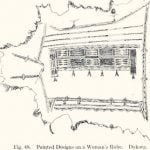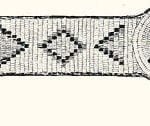The Plains Indians have a well developed decorative art in which simple geometric designs are the elements of composition. This art is primarily the work of women. Clothing and other useful articles, made of skins, were rendered attractive by designs in beads and quills. Rawhide bags and parfleche were treated with a peculiar type of painting in many colors.
Realistic art was practiced chiefly by men in the recording of war deeds and reached a high degree of excellence among the Dakota and Mandan. The technical .aspect of bead and quill work of the Plains is quite peculiar. Formerly, there was little or none of the woven work so common in the Eastern Woodlands and the forests of Canada, the method here being to lay the quills on the surface of skins in large geometric areas. The beads now in use were introduced by traders and have almost displaced the original art of porcupine quill embroidery.



The most numerous decorated objects in collections are moccasins which therefore offer an extensive design series. Though often examples of each design may be found upon the moccasins in a single tribe, the tendencies are always toward a few tribal types. Thus, the Arapaho predominate in longitudinal stripes (Fig. 45, a-d), the Dakota in definite figures (f, g, m, n, o), the Blackfoot in U-shaped figures (k), etc. Additional designs will be found upon leggings, bags, and pouches. All these designs may be resolved into simple geometrical elements or patterns (Fig. 46).

Fig. 46. Design Elements, Bead and Quill Embroidery. (Kroeber)
Here also, tribal preferences are to be found. The rawhide paintings are also geometric and though the designs first appear quite complex, they can readily be resolved into triangles and rectangles. Another point of special interest is that some tribes give these conventionalized designs a symbolic value. This is particularly true of the Arapaho.
Thus Fig. 47 shows a moccasin which is beaded around the edges, but has its front surface traversed by a number of quilled lines. The white bead work represents the ground. Green zigzag lines upon it are snakes.
The quilled lines represent sweathouse poles. These lines are red, blue, and yellow, and the colors represent stones of different colors, used for producing steam in the sweathouse. At the heel of the moccasin, which is not shown in the figure, are two small green squares. These represent the blankets with which the sweathouse is covered.
The design of a snake was embroidered on this moccasin in order that the child wearing it might not be bitten by snakes. The symbols referring to the sweathouse were embroidered on the moccasin in order that the child might grow to the age at which the sweathouse is principally used; namely, old age.

The Dakota also have interpretations for their designs but seemingly to a less degree than the Arapaho. Among other tribes, occasional cases of symbolism have been reported. In the Museum collections is a pair of moccasins from the Plains-Ojibway bearing Plains designs and accompanied by a definite symbolic interpretation. All this suggests that there must have one time been a marked undercurrent of symbolism in the art of the Plains.
It was once assumed that when you found in the art of any people a geometric design, said to stand for a definite plant or animal form, the realistic drawing was the original form from which it was derived by a process of conventionalization. When we attempt to apply this principle to the art of the Dakota and the Arapaho, for instance, we find in some cases the same geometrical figure used by both tribes but to symbolize entirely different objects. We are, therefore, forced to assume that there is no necessary connection between the life history of a decorative design and the object it symbolizes. Plains art clearly shows that often along with a style of designs, goes also a style or mode of interpretation. Since this interpretation is a reading in on the part of those having such a mode, any vague resemblance will suffice.
This is nicely illustrated in the curious U-shaped figure upon the beaded yokes of many woman s dresses. Some Teton-Dakota women once said this had always been known to them as representing a turtle s head and legs as he emerged from the lake (the beaded yoke).
Yet, somewhat similar figures occur on the dresses of other tribes from whom no such symbolism has been reported. This might be explained as brought about by the other tribes borrowing the pattern from the Teton; but when many of these garments are examined, we observe that often the U-shaped turn is made to carry the beaded border around the hairy tail of the deer left, or sewed, upon the skin from which the garment was made. The tail tuft naturally falls just below the yoke because the dresses are fashioned by joining the tail ends of two skins by a yoke, or neck piece. Hence, it seems more probable that the pattern was developed as a mere matter of technique and that later on the Teton read into it the symbolism of the turtle, because of some fancied resemblance to that animal and because of some special appropriateness.

The preceding remarks apply exclusively to objects in which the motive was chiefly decorative. There was another kind of art in which the motive was mainly religious, as the paintings upon the Blackfoot tipi, the figures upon the ghost dance shirts of the Dakota, etc. Such drawings, as with heraldry devices, were almost exclusively the work of men. Another suggestive point is that this more serious art tends to be realistic in contrast to the highly geometric form of decorative art.
In general, an objective study of this art suggests that the realistic, decorative, and other art seem to have been greatly developed on the northeastern border of the area, while the geometric was most accentuated on the southwestern. Thus on the northeast, beyond the limit of our area, the Ojibway especially possessed a highly developed pictographic type of art while the Ute (Shoshoni) of the extreme southwest of the area seem to have practiced no such pictographic art but presented in contrast a highly developed geometric type both in embroidery and rawhide painting. Taking the Arapaho and Teton-Dakota as two intermediate groups, we find the former inclining to the geometric art of their Shoshonean neighbors, while the latter show almost equal proficiency in the two contrasting types. Thus, we seem to have two influences from opposite directions, reinforcing the common suggestion that the geometric art of this area was introduced from the southwestern part of the continent.
